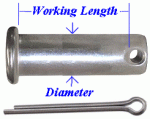Oscarpop
New member
We are unstepping the mast next week while in the water. The last time I had to remove a cotter pin from the vang, it was a little stuck, so was tapping it gently with a hammer to dislodge it, and it bounced over the side.
Can you suggest tips to stop this happening again? Holding a cloth against the other side is one thing, and having an umbrella opened under the forestay is another.
Anything else?
Cheers
Can you suggest tips to stop this happening again? Holding a cloth against the other side is one thing, and having an umbrella opened under the forestay is another.
Anything else?
Cheers


